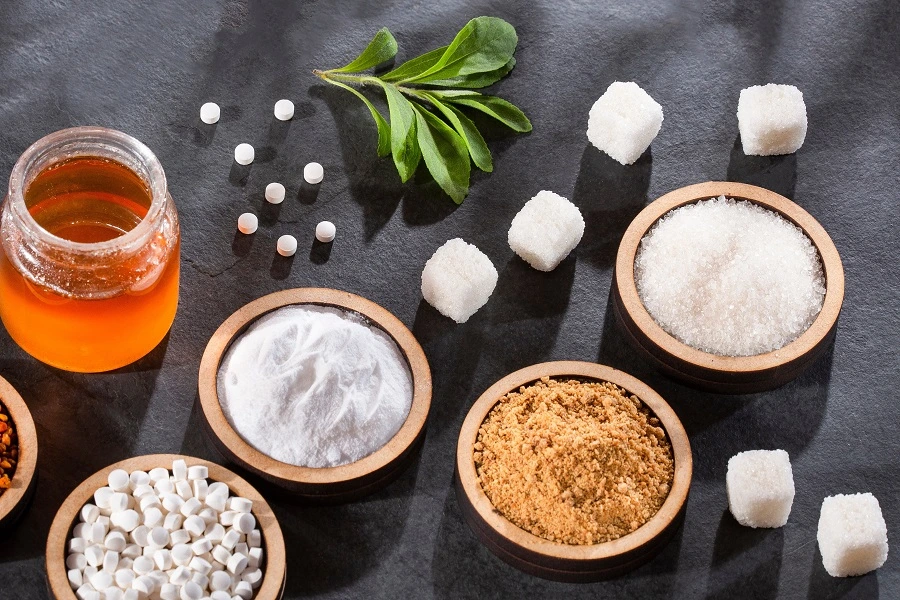
- Industry news
Industry news
- Category news
Category news
- Reports
- Key trends
- Multimedia
Multimedia
- Journal
- Events
- Suppliers
Suppliers
- Home
- Industry news
Industry news
- Category news
Category news
- Reports
- Key trends
- Multimedia
Multimedia
- Events
- Suppliers
Suppliers
Sweetener solutions: Rare sugars, sweet proteins & stevia inspire sugar reduction innovation
Key takeaways
- F&B formulators are redefining sweetness through advanced ingredient innovation, from stevia Reb M and sweet proteins to rare sugars like allulose.
- Bioconversion, fermentation, and enzymatic technologies are improving sweetness quality, functionality, and sustainability across beverages, bakery, and dairy.
- As consumers seek natural, low-calorie, and label-friendly options, industry leaders are developing sweetener systems that balance taste, health, and affordability.

Sweetener innovation is evolving as formulators converge science and sensory design to reshape how sweetness is developed across F&B categories. Reducing sugar is more important than ever for health-conscious consumers, but R&D efforts involve much more than simply swapping one ingredient for another.
From rebaudioside M to sweet-protein blends, manufacturers are using ingredient innovation, flavor engineering, and advanced bioprocessing to balance sweetness, texture, and mouthfeel across dairy, bakery, beverage, and confectionery products.
Consumer preferences drive sweetener innovation, as nearly 72% actively slash sugar from their diets, with the sweetener market growing at an average of 8% from July 2020 to June 2025, suggests Innova Market Insights data. Sucralose use leads the NPD category, while monk fruit concentrate use is growing the fastest.

Food Ingredients First speaks with Ingredion, Südzucker, Sweegen, and Tate & Lyle to explore how these advances in sweetener technologies, flavor modulation, and clean label formulation propel scalable and consumer-focused sweetener innovations.
Adams Berzins, senior manager of Global Sugar Reduction Applications at Ingredion, describes two ways to examine how the sweetener landscape has evolved over the past five to ten years: the evolution of sweetener technology and the growing complexity of consumer preferences and expectations.
“On the technology front, sweeteners today are cleaner-tasting and more affordable than ever. The best-tasting stevia molecules taste great and can reduce costs compared to sugar in many applications,” he says.
“Rare sugars like allulose are helping build back the functionality of sugar across a wide range of low- and no-sugar-added categories. Emerging technologies, many of which are based on precision fermentation, are bringing new synergies in sweet taste quality. These innovations may unlock even better and more affordable solutions, especially when combined with other nature-based sweeteners.”
Consumer and regulatory impact
Consumers and regulators have reshaped the landscape, as consumers are “more informed than ever and are actively seeking clean tasting, ethically-sourced, and affordable alternatives, not just to sugar, but also to traditional artificial sweeteners,” Berzins continues.
 Sugar taxes and warning labels push brands to make healthy yet affordable products, says Berzins at Ingredion.Ingredion’s recent proprietary global study on sweeteners in beverages found that consumers’ palates have evolved. They aren’t always chasing “sugar-like” sweetness. Many are looking for nature-based solutions that complement the existing zero-sugar taste profiles they have grown up with.
Sugar taxes and warning labels push brands to make healthy yet affordable products, says Berzins at Ingredion.Ingredion’s recent proprietary global study on sweeteners in beverages found that consumers’ palates have evolved. They aren’t always chasing “sugar-like” sweetness. Many are looking for nature-based solutions that complement the existing zero-sugar taste profiles they have grown up with.
Berzins adds that regulatory pressures, including sugar taxes and front-of-pack warning labels, are also driving change.
“These measures aim to support public health, but they create a challenge for brands: meeting healthier lifestyle expectations while keeping finished goods affordable.”
Dr. Wolfgang Kraus, director for Corporate Communications at Südzucker Group also emphasizes the impact of regulations on sweetener innovation.
“Sweeteners require international markets to justify the development costs. On the other hand, national or block regulations regarding safety, labeling, and usage must be considered. In that sense, global guidelines can be seen as landmarks for national or regional orientations.”
Push for healthier options
Consumer demand for healthier and natural options is proliferating, coinciding with a shift toward non-artificial alternatives like stevia, allulose, and monk fruit.
“The global push for sugar reduction has further accelerated this shift, with governments and health organizations implementing guidelines to reduce sugar consumption. Both non-artificial sweeteners like stevia and allulose, and other sugar reduction alternatives like sucralose, have emerged as viable solutions to meet these goals,” says Abigail Storms, global VP of Sweeteners and Fibers at Tate & Lyle.
 Health-conscious shoppers are cutting sugar, not pleasure and seek clean labels with real taste.Tate & Lyle’s Tasteva Stevia Sweetener, derived from the Stevia rebaudiana plant, offers a “zero-calorie profile,” appealing to those seeking calorie reduction. Allulose, like Tate & Lyle’s Dolcia Prima Allulose, mimics sugar’s taste and texture with significantly fewer calories.
Health-conscious shoppers are cutting sugar, not pleasure and seek clean labels with real taste.Tate & Lyle’s Tasteva Stevia Sweetener, derived from the Stevia rebaudiana plant, offers a “zero-calorie profile,” appealing to those seeking calorie reduction. Allulose, like Tate & Lyle’s Dolcia Prima Allulose, mimics sugar’s taste and texture with significantly fewer calories.
Its Splenda Sucralose offers “sweetness without calories,” and remains a popular choice for those looking to reduce sugar intake, while maintaining the desired sweetness in their diet.
“Despite some misconceptions, food safety authorities worldwide consistently reaffirm the safety of sucralose as a sweetener,” Storms adds.
Meanwhile, Ingredion focuses on digestive and metabolic health through its stevia innovations. “Metabolic health support through sugar reduction is quickly becoming the entry price. The next step is offering ingredients that go further, like helping manage glucose response without sacrificing the quality of the eating experience,” Berzins notes.
“For digestive health, it’s not just about adding fiber for fiber’s sake. We’re focused on delivering solutions that support the gut microbiome and contribute to overall health.”
Leveraging “sweet proteins”
Jenise Pratt, senior manager of commercialization at Sweegen, highlights sweet proteins as “nature’s next era of sweetness.”
“Once a scientific curiosity, sweet proteins are now commercially available, with Brazzein, the most versatile protein, leading the way. This marks a pivotal move beyond synthetic, carbohydrate-based sweeteners toward protein-based sweetness that delivers a clean, sugar-quality taste experience.”
 Sweet proteins like Brazzein move beyond carbohydrate sweeteners toward clean, sugar-quality taste, says Pratt at Sweegen.The protein molecules “expand the taste toolbox for product developers,” and help manufacturers cut sugar and elevate flavor in better-for-you products. However, Pratt describes replacing sugar as “both an art and a science.”
Sweet proteins like Brazzein move beyond carbohydrate sweeteners toward clean, sugar-quality taste, says Pratt at Sweegen.The protein molecules “expand the taste toolbox for product developers,” and help manufacturers cut sugar and elevate flavor in better-for-you products. However, Pratt describes replacing sugar as “both an art and a science.”
Sucrose delivers flavor, balance, and functionality that are difficult to replicate, making clean, sugar-like sweetness a major industry challenge. Sweegen tackles this through “advanced taste modulation tools” and ingredient systems that minimize off-notes.
Matching sugar functionality
When replicating sugar’s functionality, formulators often face technical challenges, which can be divided into bulk sweeteners, high-intensity sweeteners, and sweetness enhancers like flavors or PAMs (positive allosteric modulators), explains Kraus at Südzucker Group.
“The challenge is to create an acceptable texture, mouth feeling, and taste at once. This depends on the applications, too. Consequently, application-specific developments are needed with a bundle of ingredients.”
Meanwhile, Berzins highlights that while the sweetener innovation community has long been focused on achieving “sugar-like sweetness,” consumers enjoy a wide variety of sweetness profiles. Ingredion is working to understand not just the functionality of the molecules, but the “interaction of nature-based sweetening solutions at the physiological level and how to deliver on consumers’ complex expectations.”
“Another challenge is where sweet innovation intersects with affordability and health. Beyond sweet taste and functionality, fibers may be able to elevate sugar reduction strategies by adding health benefits like supporting the gut microbiome and providing certain glycemic health benefits,” he adds.
Matching sugar’s taste and function remains complex and is especially challenging with ingredients like stevia, allulose, and sucralose, says Storms.
 Ingredion’s Clean Taste Solutions combine over 100 steviol glycosides for balanced sweetness in drinks.“Beyond taste, sweeteners must also replicate sugar’s functional properties, including texture, bulking, and browning.” While allulose provides a “browning effect,” beneficial in baking applications, sucralose maintains stability under heat and in acidic environments.
Ingredion’s Clean Taste Solutions combine over 100 steviol glycosides for balanced sweetness in drinks.“Beyond taste, sweeteners must also replicate sugar’s functional properties, including texture, bulking, and browning.” While allulose provides a “browning effect,” beneficial in baking applications, sucralose maintains stability under heat and in acidic environments.
“The benefits of these sweeteners can be maximized by combining them and other ingredients to achieve a balance that meets both health and taste goals,” she explains.
Redefining sweetness optimization
Besides targeting sugar functionality, ingredient innovators are redefining how sweetness is created and optimized in modern formulations to meet consumer taste demands.
Ingredion’s Clean Taste Solutions are targeted sweetener solutions that combine the PureCircle by Ingredion legacy of “continued leadership in stevia innovation with a deep understanding of the potential of the over 100 distinct steviol glycosides within the stevia plant,” notes Berzins.
“Functional carbonated soft drinks and other better-for-you product brands are already bringing these solutions to their customers,” he says.
Sweegen is propelling its sweet protein as it awaits final GRAS (Generally Recognized As Safe) determination by the US FDA for its sweet protein Ultratia Brazzein, says Pratt.
“Brazzein is a complementary high-intensity sweetener that works synergistically with our signature stevia portfolio to deliver an exceptional sugar-quality sweetness. It is 500–2000 times sweeter than sugar and offers a pleasant, clean taste experience with exceptional formulation versatility and stability across a range of pH and temperature conditions.”
The sweetener can engage both T1R2 and T1R3 receptors — the same receptor pair activated by sucrose — helping Brazzein deliver both a high sweet quality (clean, rounded, and harmonious sweetness) and an authentic sucrose-like sweetness curve.
 Bioconversion technology helps make Reb M more sustainably and strengthen the supply chain against climate shocks, says Storms at Tate & Lyle.Tate & Lyle’s Tasteva M Stevia Sweetener offers a “clean, sugar-like” taste with minimal bitterness, notes Storms. The ingredient is a “bioconverted stevia Reb M,” which addresses the taste challenge with traditional stevia products.
Bioconversion technology helps make Reb M more sustainably and strengthen the supply chain against climate shocks, says Storms at Tate & Lyle.Tate & Lyle’s Tasteva M Stevia Sweetener offers a “clean, sugar-like” taste with minimal bitterness, notes Storms. The ingredient is a “bioconverted stevia Reb M,” which addresses the taste challenge with traditional stevia products.
The company’s Dolca Prima closely delivers 70% of the sweetness of sugar and 90% fewer calories. “Its unique properties allow it to replicate sugar’s functional roles, such as browning and bulking, making it particularly suitable for applications in baking, confectionery, and beverages.”
Emerging techniques
Berzins at Ingredion highlights the emerging techniques in sweetener innovation as consumers increasingly prefer the taste combinations that sweetener technologies can provide. In application, sugar reduction solutions bringing existing tools together with emerging technologies will make “big changes to what is possible for clean sweet taste,” he says.
“Naturally inspired approaches like fermentation and enzyme activity are increasingly shaping sweetener innovation, with exciting potential to introduce novel options such as sweet proteins.
These nature-inspired techniques help bring rare ingredients to market and offer more consistent and scalable solutions than traditional extraction methods.
Meanwhile, Storms at Tate & Lyle tells us that bioconversion methods are transforming sweetener formulation by improving taste, functionality, and sustainability.
“By using bioconversion technology, manufacturers can produce Reb M with less environmental impact and enable a more resilient supply chain that is less susceptible to disruption caused by climate change-related events.”
 Future systems will merge intense and bulk sweeteners for both health and flavor benefits, says Kraus at Südzucker Group.
Future systems will merge intense and bulk sweeteners for both health and flavor benefits, says Kraus at Südzucker Group.
Future of sweet taste
In the future, Kraus at Südzucker Group expects sweetening systems to evolve through smarter combinations of intense and bulk sweeteners, delivering both health benefits and taste. He notes that while sugar reduction is “easier in beverages,” bulk sugar replacers and flavor modulation innovation will drive progress in more complex food applications.
For Pratt at Sweegen, the future of sweetness is rooted in “precision, sustainability, and authenticity.”
“We also anticipate greater scrutiny of artificial sweeteners and an increasing demand for nature-based, label-friendly ingredients that align with consumer expectations for transparency and wellness. In parallel, rare sugar technologies like allulose, tagatose, and kojibiose are opening new pathways to achieve sweetness with functional and metabolic benefits.”











